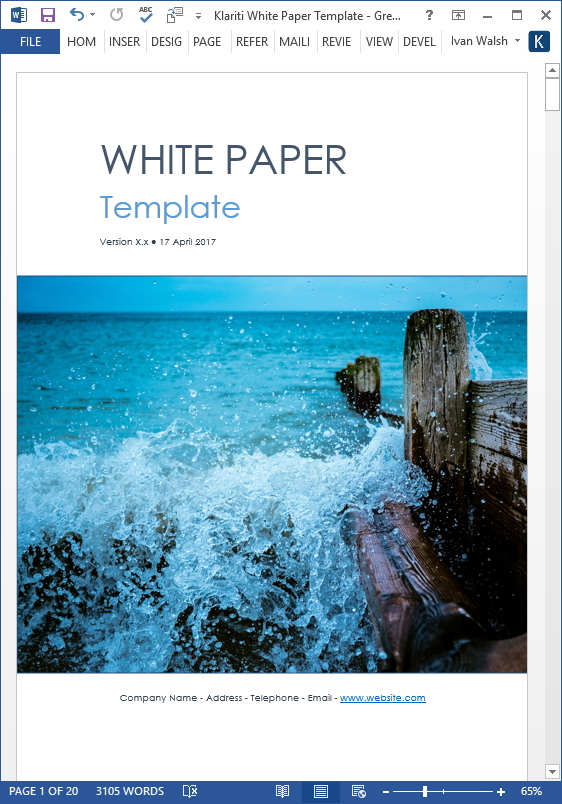White Paper Templates
White Papers: How to Create an Outline
Why do we need to create an outline for our white paper?
An outline helps you with the following:
- Keep track of all the moving parts
- Identify the main sections at a glance
- Help you to structure the document
- Identify gaps
- Ensure that themes are mentioned in the correct location
- Help you transition from one idea to the next
- Ensure you don’t get lost.
An outline serves as a type of document map.
Green Energy theme – ideal for environmental, health, and energy-related white papers.
White Paper templates – MS Word and Excel
Learn More about these white paper templates
You can use it to see where you are, where you need to go next, and what paths are open to you. Without it, you will still get to the end but could overlook something in the process. An outline protects you from this. So, how do we start?
White Paper Outline
The outline has three parts:
- Start
- Middle and
- End
Of course, these can, and are, broken down into sub-sections. Most of the time, the middle is a series of inter-connected chapters, which discuss the underlying problem and examples of how to resolve it.
There are different ways to approach this but the problem-solution formula trends to provide the most value to the reader.
Why?
It highlights issues they are likely to have and then proposes ways to address these. If you sidestep this, the document may still have value but may not resonate with the reader. Talking about the problem demonstrates your knowledge of the issue.
Document Structure
In general, the document has the following parts:
Start – Chapter 1
- Orient the reader – don’t jump into the problem immediately. Instead, help the reader understand why you’ve chosen this topic, its background, and if this is part of a larger problem.
- Why are you discussing this topic? Help the reader understand why you are discussing this topic now. This helps them determine if they are interested in the topic, warms them up for what’s coming next .
- Introduce a fact, statistic, or research finding that puts things in context. Use the last paragraph to lead into the next chapter.
Middle – Chapter 2
This discuss where we are now.
Sub chapters look at
- Risks
- Costs
- Barriers
- Solutions
- Case Studies and Examples
End – Chapter 3
The final chapter is where you recommend next steps. In other words, you are saying to the reader, now that you’ve seen the problem and the possible solution, we suggest you take the following action.
Document Outline Matrix
Create a matrix in Excel to keep track of all the section in the document. Create columns for chapter, topic, key points, and priority. Then, populate the matrix with the title of each chapter.
- Identifier – track the sections and sub-sections
- Executive Summary – this can be seen as a standalone document which serves as a one page summary for the document which follows.
- Chapter – identify the main sections in the white paper
- Topic – identify the topics you want to cover in each section. For example, the first chapter may have three heading: overview, risks, and opportunities
- Key points – identify each point and how it relates to your themes
- Priority – assign a value to each of the items you want to discuss.
Challenges Table
Identify the challenges and potential ways to address them. Create a table and use the following three-part structure:
- Challenges – identify the challenge and potential ways to address them.
- What has happened in the past – for example, centralised systems meant there was a single point of failure if this database was breached.
- Potential ways to tackle the problem – for example, federated solutions with standards-based interfaces conforming to a set of agreed principles.
This challenge table allows the reader to see the main issues at a glance.
It also shows that you, the author, have identified the issues. By adding columns for what happened in the past and how you can tackle these in the future, you are planting the seed of how you can help resolve these issues.
Summary
The most popular white papers are those which explain how others businesses solved this problem. If you look at the HBR, you’ll see this. They interview business leaders, ask them what issues they faced – the more specific the better – and then how they fixed this.
If you suggest your product, you position the document as a sales pitch. Instead, suggest how they could begin to address this problem.
Use the document as a way to position yourself as an authority. This means other will share it, recommend it, and see you as a trusted source.

Business Solution theme – ideal for commercial, fashion, and energy-related white papers.
White Paper templates – MS Word and Excel
Learn More about these white paper templates

